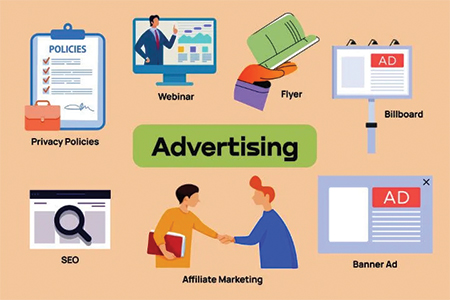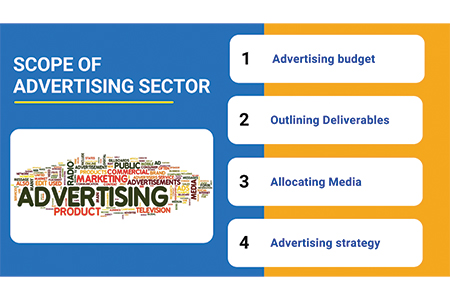Scope of Advertising
What is Advertising?
Advertising is the methodical exercise of communication designed to market products, services, or concepts to a targeted market. Advertising is a vital tool that determines the attitude of the consumer, boosts sales, and promotes loyalty to a brand. Beyond promotion, the field of advertising spans education, persuasion, and reminding an audience of worth. Whether it's via old-fashioned primary advertising or the constantly changing breadth of online advertising, its strength comes from shaping decisions at the optimal time. A campaign written well doesn't only tell; it connects, leaving a lasting impression. Advertising today isn't just static, it follows the variance of the marketplace, the development of media, and the changing habits of the audience.

Scope of Advertising

Scope of Advertising by Media Type
Various media forms provide different advantages in advertising. From television and print to the vast platform of online advertising, each medium appeals to specialized audiences and campaign objectives. While mainstay advertising via TV or radio constructs general awareness, digital media enables focused targeting. Social media, websites, podcasts, and mobile apps have opened up the playing field, allowing brands to reach consumers through multiple touchpoints. This varied media blend keeps advertising nimble, salient, and performance-oriented.
Scope of Advertising by Target Geography
Geography plays an important role in determining the way advertising messages are developed, distributed, and paid for. A regional campaign can count on traditional primary modes of advertising, such as billboards or local radio, whereas international campaigns necessitate culturally adjusted approaches, which frequently fall back on the wider scope of internet advertising. Geographical distribution affects not just the style of messaging and words but also the selection of media and budgeting. Knowledge of regional behaviors guarantees messages resonate, optimizing impact at all levels.
Scope of Advertising by Budget and Scale
Advertising tactics range from wildly diverse by budget and campaign size. A small business may concentrate on online ads and organic visibility under the umbrella of online advertising, whereas big businesses can sustain multi-channel, worldwide campaigns with strong base-level advertising. Budget dictates it all, from platform and content quality to frequency and length. From lean local deployment to worldwide launch, careful budgeting allows every dollar to add substantially to campaign effect.
Scope of Advertising by Deliverables and Allocation
An effective campaign is greatly reliant on the planning and administration of its deliverables. From the creative imagery and compelling copy to the chosen platforms and timing, each element sets the parameters of advertising. Resource allocation among design, production, media purchase, and analysis governs efficiency and results. Both main advertising campaigns and digital strategies are dependent upon keen coordination to ensure consistency and achieve performance objectives, particularly in dynamic, multi-channel situations.
Scope of Advertising by Strategy Type
Strategy powers the pulse of each ad campaign. Leveraging primary advertising for broad reach or the reach of online advertising for targeted niches, decisions are based on audience action and desired interaction. Some seek to bring conversions immediately, while others seek to accumulate long-term brand equity. From narrative to data-driven personalization, the chosen method dictates not only what's communicated, but how, when, and where it's presented in order to maximize impact and outcomes.
Scope of Advertising by Industry
Advertising is never a one size fits all affair, every business has its beat. Retailing tends to favor visual communications and promotions, whereas service industries could be more focused on credibility and competence. The breadth of advertising changes according to customer journey phases, product sophistication, and decision horizons. For example, e-commerce lives on real-time interaction through digital media, whereas healthcare might rely on credibility developed through original advertising. The tone, channel, and strategy at each step are defined by the industry context.
Scope of Advertising at Point of Engagement
The point when a customer is ready to act is key. Point of engagement advertising targets real-time influence, either through in-store signage, app alerts, or timely search results ads. This is where primary advertising and the reach of online advertising meet to trigger action. Strategies are fast, fact-based, and emotionally engaging, intent on crossing interest over into immediate action. The message must be clear, the timing perfect, and the setting seamless.

Conclusion
Advertising is a complex science that impacts awareness, perception, and behavior. Be it traditional primary advertising or the ever-evolving expanse of online advertising, effectiveness comes from being adaptable. Medium, geography, budget, industry, and strategy all determine how campaigns are constructed and delivered. The only thing that does not change is the objective, to connect meaningfully with people. With each progression of technology and change in consumer habits, advertising gets reimagined, remains relevant, effective, and central to business expansion.
FAQs
International campaigns are modified to accommodate several cultures and languages, whereas local ads address local tastes, media consumption, and consumer behavior to be more relevant and effective.
Social media, search advertising, and programmatic solutions increase the reach of internet advertising via targeted exactness, real-time monitoring, and measurable outcomes across populations and geographies.
Every business has a unique customer path. Retail emphasizes immediate appeal, e-commerce emphasizes immediate clicks and conversions, and services emphasize trust, determining how ads are constructed and served.
Thoughtful separation of design, messaging, media buy, and measurement creates campaign architecture, holds people accountable, and aligns execution with the overall advertising approach and goals.
Audience profile, budget size, campaign objectives, media channels, creative direction, and timing are all key factors that determine the planning and effectiveness of an advertisement campaign.



